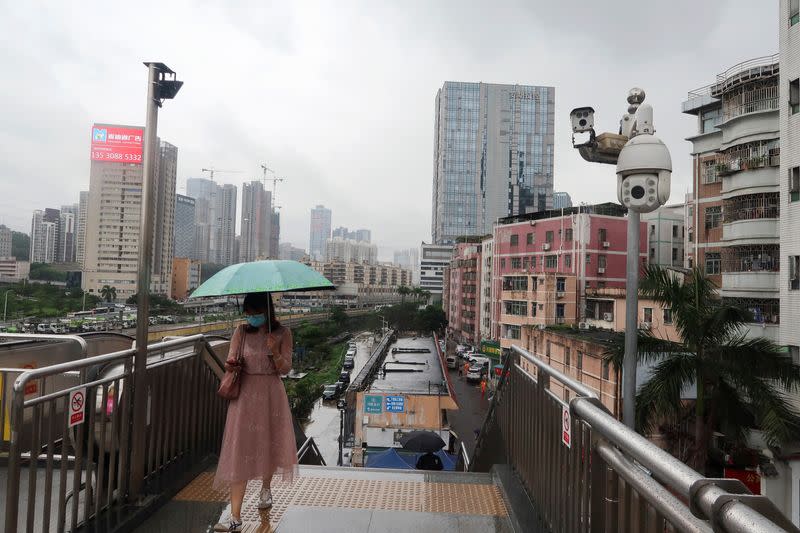In China's Shenzhen, nostalgia persists for the old days of Hong Kong culture
By David Kirton
SHENZHEN, China (Reuters) - A trip to glamorous Hong Kong was a distant dream for most Chinese mainlanders in the mid-1990s, but for schoolgirl Tracey Chen in the southern boomtown of Shenzhen, it was just a lunchtime stroll.
As Hong Kong loses autonomy after 25 years of Chinese rule, Chen is among many of those in its Mandarin-speaking neighbour who yearn for the days when the former British colony's uniquely exuberant Cantonese culture permeated across the border.
Before Shenzhen began to be transformed in the 1980s, Hong Kong's freewheeling economy represented a consumer haven for many from the mainland.
Chen's school still stands on Sino-British Street, a 250-metre (273-yard) road sliced down the middle by the boundary between the territories, and the sole stretch where they are not separated by water.
As border guards kept a close eye on visitors browsing instant noodles, beauty products and other mainland rarities, Chen would pocket her communist student's red scarf and slip across to buy ice cream and magazines about Hong Kong popstars.
"There were some that came out once a week," she reminisced. "My classmates and I would take turns to go and get them."
TIDE CHANGE
Shenzhen was a sleepy trading town surrounded by hundreds of villages before the leader at the time, Deng Xiaoping, approved one of China's first special economic zones (SEZ) there in 1980, in part to stop an exodus of those risking their lives to flee.
Liang Ailin, born in the village of Caopu in 1969, still remembers desperate villagers clambering onto cargo trains leaving for Hong Kong.
"Almost everyone in the villages has family members who fled," she said, speaking over a dim sum meal of Cantonese delicacies with friends, a stones' throw from the gleaming headquarters of software giant Tencent.
Villagers told tales of escapees such as Li Ka-Shing, a native of Guangdong province who fled to Hong Kong and became one of its leading tycoons, said Liao Wenjian.
"We all imagined Hong Kong was heaven in the 1970s," said Liao, another Shenzhen resident born in 1969. "As long as you work hard, you won't starve and you'll make a lot of money."
But after 1980, businesses in Hong Kong, well into its own export-led processing boom, poured across the border with more than 90% of Shenzhen's investment to pioneer industry there, as its officials learnt from their neighbour's market economy.
The flood of escapees ebbed soon afterwards.
SOFTSHELL TURTLES
Many of Shenzhen's original residents spoke the Hakka language and from 1984 its schools taught in Mandarin, but the power of Hong Kong business and the appeal of its music and films gave Cantonese the edge in prestige, said Liang and Liao.
In the 1980s Guangdong authorities periodically tore down antennas that might pick up Hong Kong television programmes, with their corruptingly colourful, romantic dramas and martial arts films.
But picking up the Hong Kong signals was easy in adjacent Shenzhen, which had 80 television sets for every 100 households by 1985, a year after Shenzhen launched its own rival station with news anchors in Western clothes.
"My husband, a northerner, learnt Cantonese from the TV," Liao said.
Along with her popstar glossies, Chen would buy fashion titles for her aunt, who would scrutinise them for the latest trends and make clothes for people on the mainland, she said.
Yet the admiration was not mutual, since many Hong Kong visitors viewed their mainland cousins as country bumpkins, said Fang Yan, who came to Shenzhen in the 1980s.
Some border areas became notorious as "mistress villages" for the number of wealthy Hong Kong men who had second wives living there.
"We'd call them softshell turtles (rich easy targets) and the pretty girls would say, 'Here come the rich Hong Kong guys!'," said Fang Yan. "The pretty girls were waiting for them."
BEYOND 1997
As visits to Hong Kong became easier in the years after its handover to China in 1997 and Shenzhen's economy continued to boom, some of the sheen came off the former British territory, however, Liao added.
"I realised the glamour of Hong Kong is just for the people at the top of the social pyramid - the wealth gap is too wide," said Liao.
"We're no less well off living in Shenzhen now."
Today, Shenzhen is China's third richest city, with hundreds of thousands of migrants among its population of 17.6 million, few of whom have links to the Cantonese language and culture.
The old train tracks next to Liang's village are now a tourist attraction, sandwiched between a high-speed rail line and a Bentley garage.
Young Chinese come dressed up to take photographs of themselves next to a vintage train home to a cafe, 'Happy Station', which serves bubble tea.
Many friends of Liang, Liao and Fang lament the poor Cantonese skills of their grandchildren, but see this development as being inevitable.
"It's a migrant city and a melting pot," said Liao. "We don't have thousands of years of Cantonese culture."
(Reporting by David Kirton; Editing by Anne Marie Roantree and Clarence Fernandez)

 Yahoo News
Yahoo News 




